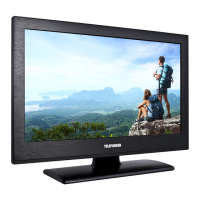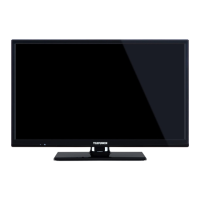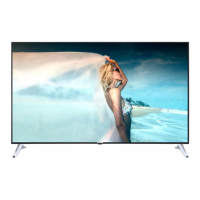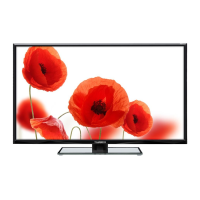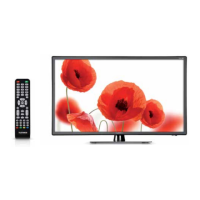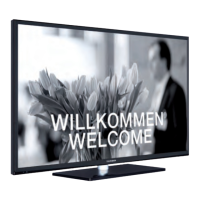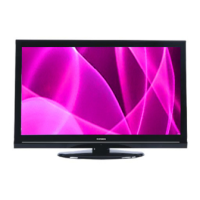Do you have a question about the Telefunken L32H125A3 and is the answer not in the manual?
Covers preparation, intended use, power source, and positioning for safe operation.
Details on ventilation, heat, moisture, liquids, and screen care.
Guidance on power cord, plug, cleaning, and wall mounting.
Utilize Power Save Mode and disconnect when not in use to save energy.
Refer all servicing and repairs to qualified personnel only.
Details on connectivity, EPG, Teletext, media playback, and more.
Detailed guide on operating volume, channels, source, and standby via TV controls.
Using the directional control switch for volume, channels, source, and standby modes.
Explanation of functions for each numbered button on the remote control.
Details on using 'My button 1' and 'My button 2' for custom functions.
Illustrates various connectors like Scart, HDMI, USB, and required cables.
Important notes on using Side AV, SCART, and CI modules.
Steps to obtain, insert, and activate a Conditional Access Module (CAM).
Explains messages for 'No Signal' and 'No operation' standby states.
Instructions for inserting AAA batteries into the remote control.
Guide to connecting power, aerial, or cable/satellite sources.
Steps for initial setup including language, country, and channel search.
Guide to setting up aerial connection for digital terrestrial TV broadcasts.
Instructions for network search and setup for cable TV.
How to select and sort broadcasts in the channel list by type.
Choosing antenna type (Direct, Unicable, DiSEqC) for satellite setup.
How to edit, sort, and manage stored channels in the list.
Guide to connecting USB drives for playing media files.
How to access video, music, and picture files from connected USB devices.
Adjusting the picture size and aspect ratio for optimal viewing.
Using the Q.MENU button for quick access to Power Save, Picture Mode, etc.
Adjusting Mode, Contrast, Brightness, Sharpness, Colour, and Power Save.
Configuring Dynamic Contrast, Colour Temp, Picture Zoom, and HDMI True Black.
Specific settings for PC input including Autoposition, H/V Position, Dot Clock, and Phase.
Controlling Volume, Equalizer, Balance, Headphone, and Sound Mode.
Details on scanning for Digital Aerial, Cable, Analogue, and Satellite channels.
Using manual scan, analogue fine tuning, and first-time installation.
Settings for conditional access modules, language, and parental controls.
Configuring program timers, date, and time settings.
Managing network settings, scanning encrypted channels, and blue background.
Options for store mode and DLNA renderer features.
Configuring power up modes and enabling/disabling virtual remote.
Setting the BISS key for specific satellite broadcasts.
Viewing programme info, selecting channels, and managing EPG options.
Steps to connect the TV to a wired LAN network via Ethernet.
Managing wired and wireless network connections for IP address.
Setting up the TV as a wired device and checking connection status.
Connecting to smartphones/tablets for content sharing via DLNA.
Explanation of DLNA and troubleshooting connection issues.
Selecting and playing video files from network or USB sources.
Steps to access and use the Internet Portal for online services.
Overview of HbbTV, its services, and interaction via remote control.
How remote control keys interact with HbbTV applications and AV content.
Describes application running, termination, and autostart behaviour.
Illustrates EPG and video display within an HbbTV application.
Using Teletext, Mix Mode, Index, Reveal, and Subcode Pages.
Explanation of FASTEXT and TOP text systems for teletext navigation.
Using SatcoDX for satellite data management via USB.
Guide to manual, background, and 3 AM automatic software search and update.
Solutions for image persistence, poor picture, and no sound issues.
Troubleshooting no power, remote operation, and input source selection problems.
Table listing typical video display modes and supported resolutions.
Guidelines for disposing of old equipment and batteries responsibly.
Lists TV broadcasting standards, digital reception types, and channel indicator.
Details on audio output power, power consumption, and physical dimensions.
Information regarding Dolby, DLNA, and HDMI trademarks.
Details on supported video file extensions, codecs, and resolutions for movies.
Lists supported audio file formats and image file types.
Information on supported subtitle file extensions.
Table showing DVI resolutions supported at various frequencies.
Step-by-step instructions for installing Nero MediaHome software.
Accepting license conditions and choosing installation type.
Checking prerequisites and initiating the installation process.
Options for participation in anonymous data collection for service improvement.
Adding folders to share and starting the server for network access.
Displaying and refreshing media types from the library, stopping the server.
Covers preparation, intended use, power source, and positioning for safe operation.
Details on ventilation, heat, moisture, liquids, and screen care.
Guidance on power cord, plug, cleaning, and wall mounting.
Utilize Power Save Mode and disconnect when not in use to save energy.
Refer all servicing and repairs to qualified personnel only.
Details on connectivity, EPG, Teletext, media playback, and more.
Detailed guide on operating volume, channels, source, and standby via TV controls.
Using the directional control switch for volume, channels, source, and standby modes.
Explanation of functions for each numbered button on the remote control.
Details on using 'My button 1' and 'My button 2' for custom functions.
Illustrates various connectors like Scart, HDMI, USB, and required cables.
Important notes on using Side AV, SCART, and CI modules.
Steps to obtain, insert, and activate a Conditional Access Module (CAM).
Explains messages for 'No Signal' and 'No operation' standby states.
Instructions for inserting AAA batteries into the remote control.
Guide to connecting power, aerial, or cable/satellite sources.
Steps for initial setup including language, country, and channel search.
Guide to setting up aerial connection for digital terrestrial TV broadcasts.
Instructions for network search and setup for cable TV.
How to select and sort broadcasts in the channel list by type.
Choosing antenna type (Direct, Unicable, DiSEqC) for satellite setup.
How to edit, sort, and manage stored channels in the list.
Guide to connecting USB drives for playing media files.
How to access video, music, and picture files from connected USB devices.
Adjusting the picture size and aspect ratio for optimal viewing.
Using the Q.MENU button for quick access to Power Save, Picture Mode, etc.
Adjusting Mode, Contrast, Brightness, Sharpness, Colour, and Power Save.
Configuring Dynamic Contrast, Colour Temp, Picture Zoom, and HDMI True Black.
Specific settings for PC input including Autoposition, H/V Position, Dot Clock, and Phase.
Controlling Volume, Equalizer, Balance, Headphone, and Sound Mode.
Details on scanning for Digital Aerial, Cable, Analogue, and Satellite channels.
Using manual scan, analogue fine tuning, and first-time installation.
Settings for conditional access modules, language, and parental controls.
Configuring program timers, date, and time settings.
Managing network settings, scanning encrypted channels, and blue background.
Options for store mode and DLNA renderer features.
Configuring power up modes and enabling/disabling virtual remote.
Setting the BISS key for specific satellite broadcasts.
Viewing programme info, selecting channels, and managing EPG options.
Steps to connect the TV to a wired LAN network via Ethernet.
Managing wired and wireless network connections for IP address.
Setting up the TV as a wired device and checking connection status.
Connecting to smartphones/tablets for content sharing via DLNA.
Explanation of DLNA and troubleshooting connection issues.
Selecting and playing video files from network or USB sources.
Steps to access and use the Internet Portal for online services.
Overview of HbbTV, its services, and interaction via remote control.
How remote control keys interact with HbbTV applications and AV content.
Describes application running, termination, and autostart behaviour.
Illustrates EPG and video display within an HbbTV application.
Using Teletext, Mix Mode, Index, Reveal, and Subcode Pages.
Explanation of FASTEXT and TOP text systems for teletext navigation.
Using SatcoDX for satellite data management via USB.
Guide to manual, background, and 3 AM automatic software search and update.
Solutions for image persistence, poor picture, and no sound issues.
Troubleshooting no power, remote operation, and input source selection problems.
Table listing typical video display modes and supported resolutions.
Guidelines for disposing of old equipment and batteries responsibly.
Lists TV broadcasting standards, digital reception types, and channel indicator.
Details on audio output power, power consumption, and physical dimensions.
Information regarding Dolby, DLNA, and HDMI trademarks.
Details on supported video file extensions, codecs, and resolutions for movies.
Lists supported audio file formats and image file types.
Information on supported subtitle file extensions.
Table showing DVI resolutions supported at various frequencies.
Step-by-step instructions for installing Nero MediaHome software.
Accepting license conditions and choosing installation type.
Checking prerequisites and initiating the installation process.
Options for participation in anonymous data collection for service improvement.
Adding folders to share and starting the server for network access.
Displaying and refreshing media types from the library, stopping the server.
| Screen Size | 32 inches |
|---|---|
| Display Technology | LCD |
| HDMI Ports | 2 |
| USB Ports | 1 |
| Refresh Rate | 60 Hz |
| Aspect Ratio | 16:9 |
| Built-in Tuner | DVB-T/C |
| Resolution | 1366 x 768 |

